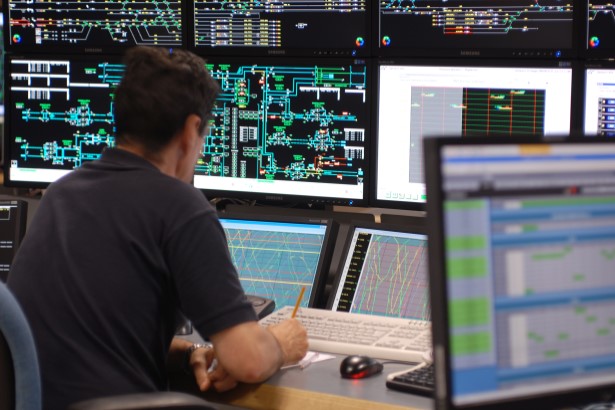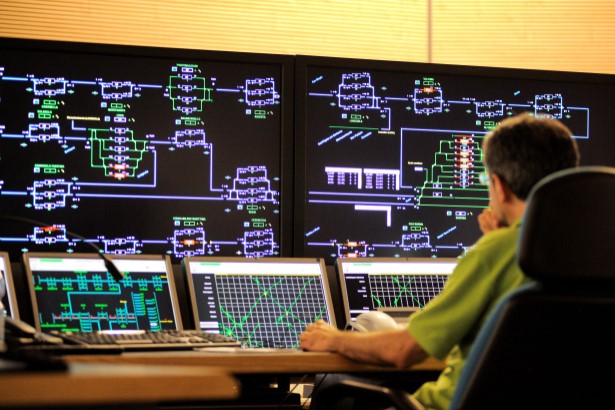



GSM-R (GSM-Railway) is an international mobile phone standard for railway communications. Primarily used for communication between trains and control centers, it is a part of ERTMS (European Rail Traffic Management System).
Italferr is engaged in the executive design and upgrade of the GSM-R system serving ERTMS implementations on the Florence - Rome DD line, and on the Milan - Genoa, Novara - Venice, Verona - Brenner, Milan - Chiasso and Vicenza - Trieste - Villa Opicina interoperable corridors, in addition to the capacity increase in the Rome and Milan railway hubs serving the High Density ERTMS system.
The Italian GSM-R network has been developed since 2004 and has grown to cover more than 10,000 km of lines, including more than 1,000 in tunnels.
Safety in galleries
Italferr has carried out the design, realisation and installation of the interfacing of the Multifunction Portals with the signalling systems.
These are Transiting Rolling Stock Monitoring Systems, installed along lines to protect tunnels longer than 1,000 m, in order to continuously and automatically assess the gauge boundary profile, detected via a camera system, or the presence of fires and open flames on board, detected via a thermal scanner system, and to report any alarms to the Signalling System.
European Rail Traffic Management System (ERTMS): a European Rail Traffic Management System that ensures interoperability among national rail systems.
Italferr is engaged in the realisation of an ERTMS/ETCS-type train spacing system superimposed on the pre-existing national systems (various types of BA (Automatic Block) and SCMT (Discontinuous Train Cab Signalling system)) on some routes in northern Italy that belong to the interoperable corridors: Mediterranean, Rhine-Alpine and Scandinavian-Mediterranean:
Lot 1: ERTMS L2 on the Novara-Padua-Venice section (Mediterranean corridor)
Lot 2: ERTMS L2 on the Verona-Brenner section (Scandinavian-Mediterranean corridor)
Lot 3: ERTMS L2 on the Milan-Genoa section (Rhine-Alpine corridor)
Lot 4: ERTMS L1 on the Vicenza-Trieste/Villa Opicina section (Scandinavian-Mediterranean corridor).
The objective of the intervention is to develop an innovative signalling system that is capable of handling the largest number of trains realistically conceivable without facing onerous infrastructural interventions, making maximum use of the existing infrastructure and technological facilities.
The planned time horizon for completion is the end of 2024.
Milan, Florence and Rome Hubs
The project consists in equipping the Milan, Florence and Rome hubs by implementing the ERTMS system with HD functionality superimposed on the existing train spacing and protection systems. The new system aims to increase the capacity of the railway hub through the optimisation of its main components:
ETCS (European Train Control System) for the command and control part: a level 2 continuous system is used, optimized and integrated with interlocking logics.
GSM-R for ground-to-train communication: properly optimised to maximise "Quality of Service" and supply in terms of channels/trains.
Traffic Management Layer: addition of optimisation of traffic scheduling of rolling stock specialised for high density and of related route generation time.
From a functional point of view, therefore, an "ERTMS HD" operating regime is envisaged with specialized and consecutive batteries of trains, such as to achieve "high density" at the hub. At the same time, the possibility of having mixed traffic between HD and non-HD equipped trains is maintained. Under degraded conditions at the ETCS Level 2 system also, each train specialized for High Density must in any case be able to run in SCMT mode. The timing of implementation is strictly dependent on the availability of ACC-M (Multistation Central Interlocking) systems, deployed at the sites affected by the intervention. With this in mind, activation will take place in functional phases with the ultimate completion date estimated between late 2023 and early 2025.
In addition to equipping the interoperable corridors and to implementing the High Density (HD) system, the implementation of ERTMS is also planned on the off-TEN network and the acceleration of the ERTMS-driven network technology renewal plan to equip the entire Italian railway infrastructure; along with the installation of ERTMS, the decommissioning of the national class B SCMT or SSC system is also planned.
In order to take full advantage of the potential offered by ERTMS level 2/3 applications, it is necessary that the ERTMS implementation works also be coordinated with the upgrading and extension of GSMR (Global System for Mobile Communications – Railway), with the modernization plan of old-generation central equipment (ACEI, ACE, etc.) using modern Central Computerized Multistation Apparatuses (ACC, ACCM), and with the technology plan for the implementation of the Multistation Command and Control System (SCCM) for the upgrading of the lines not remotely controlled and the upgrade for the interface with ACCM and ERTMS.